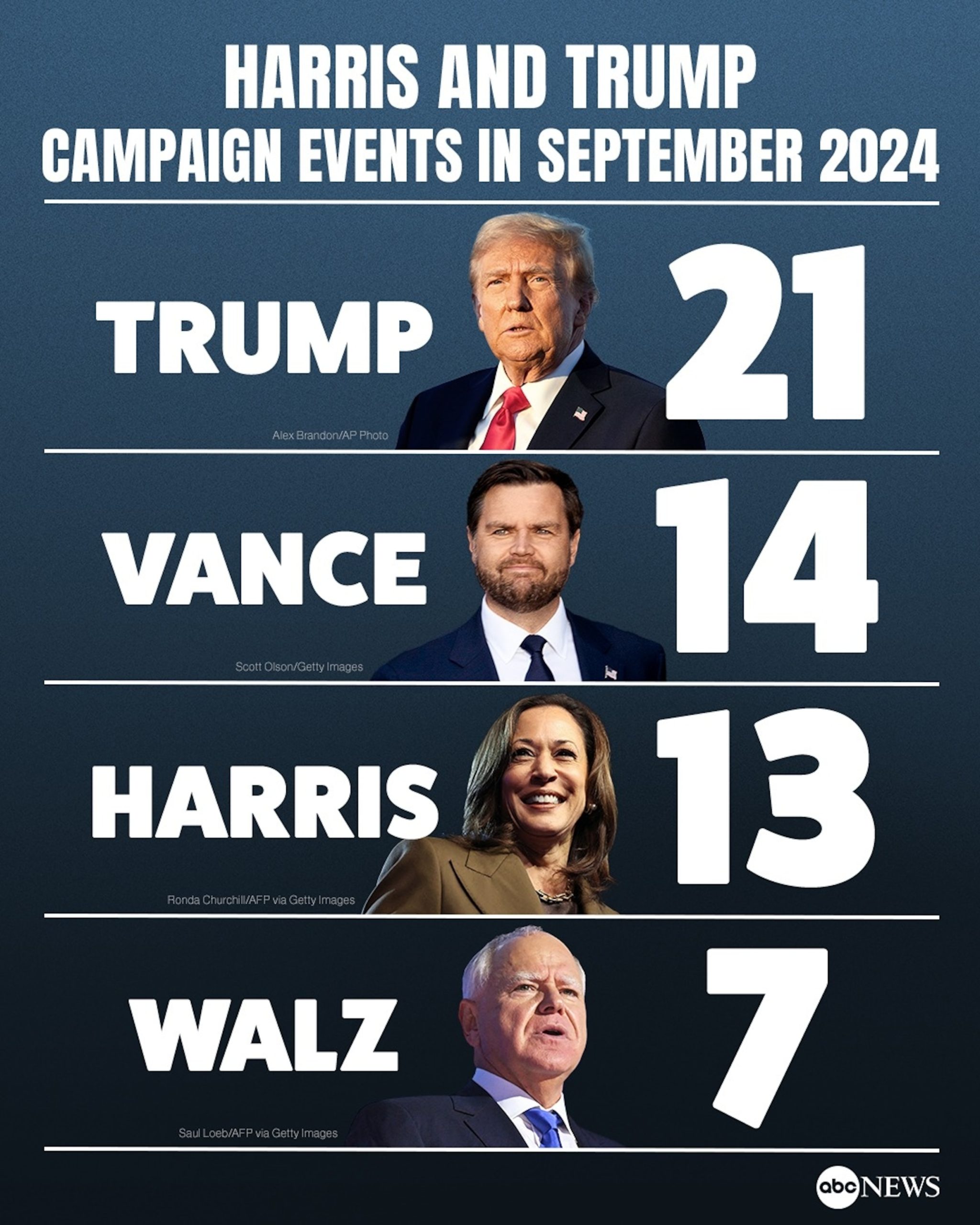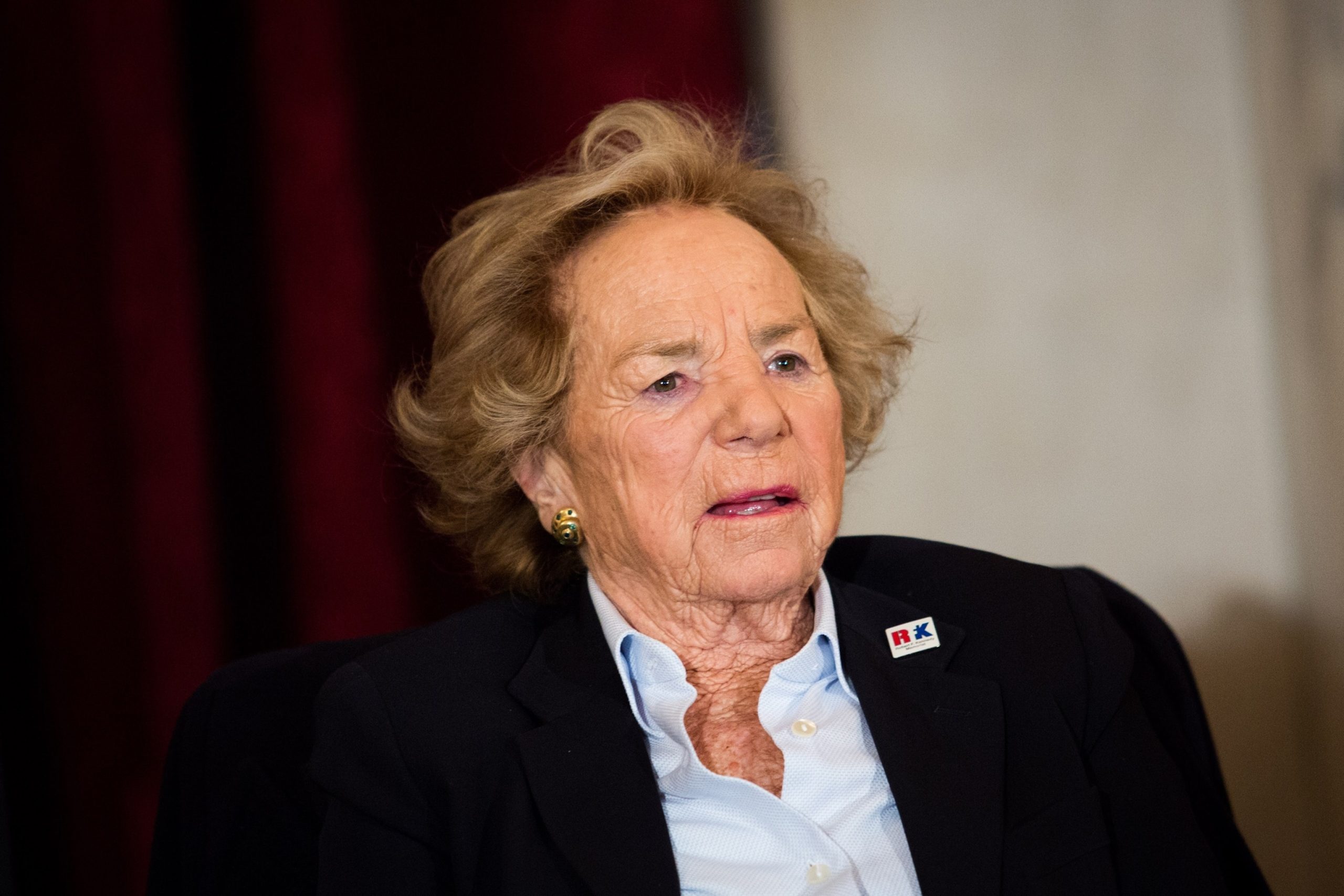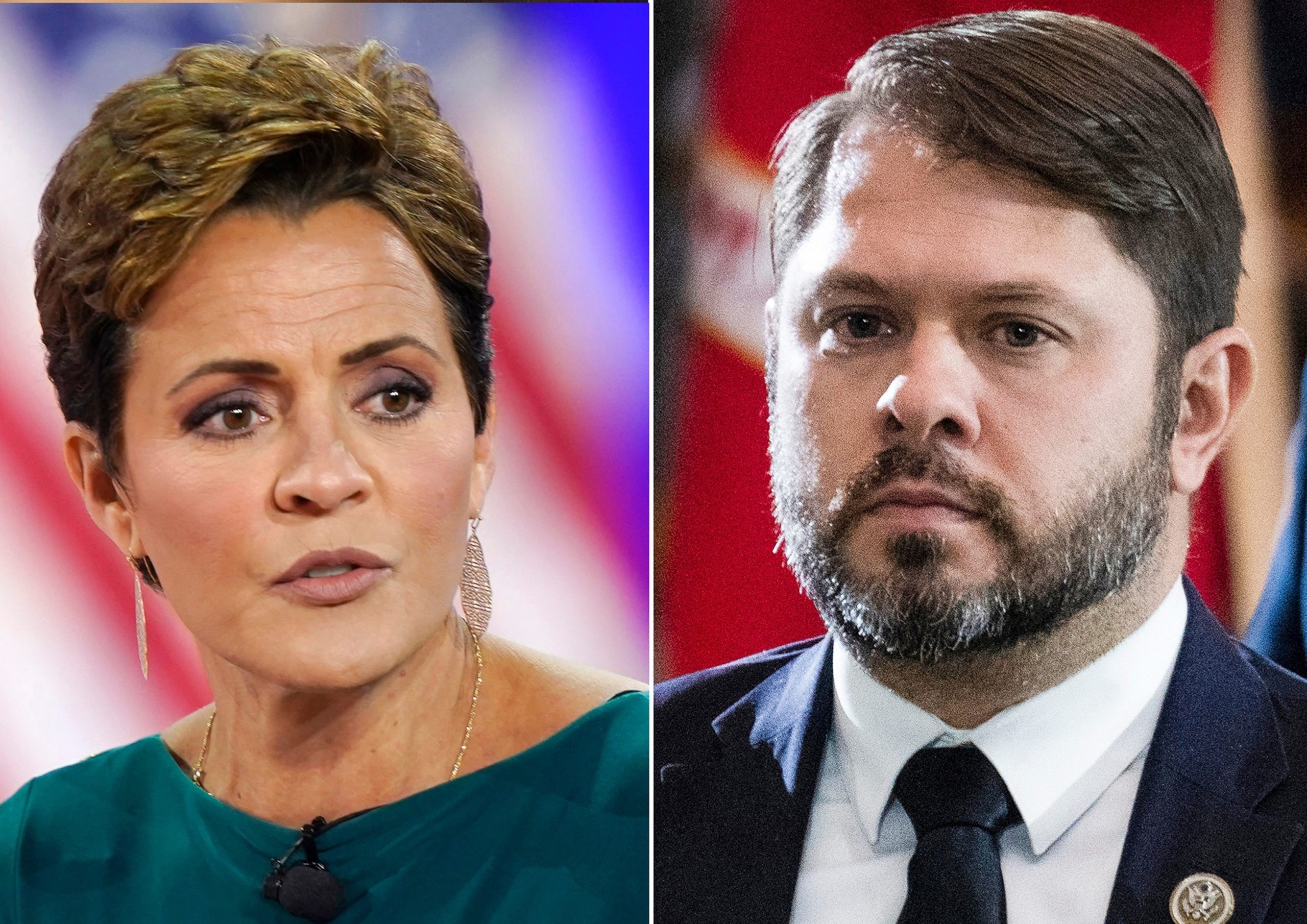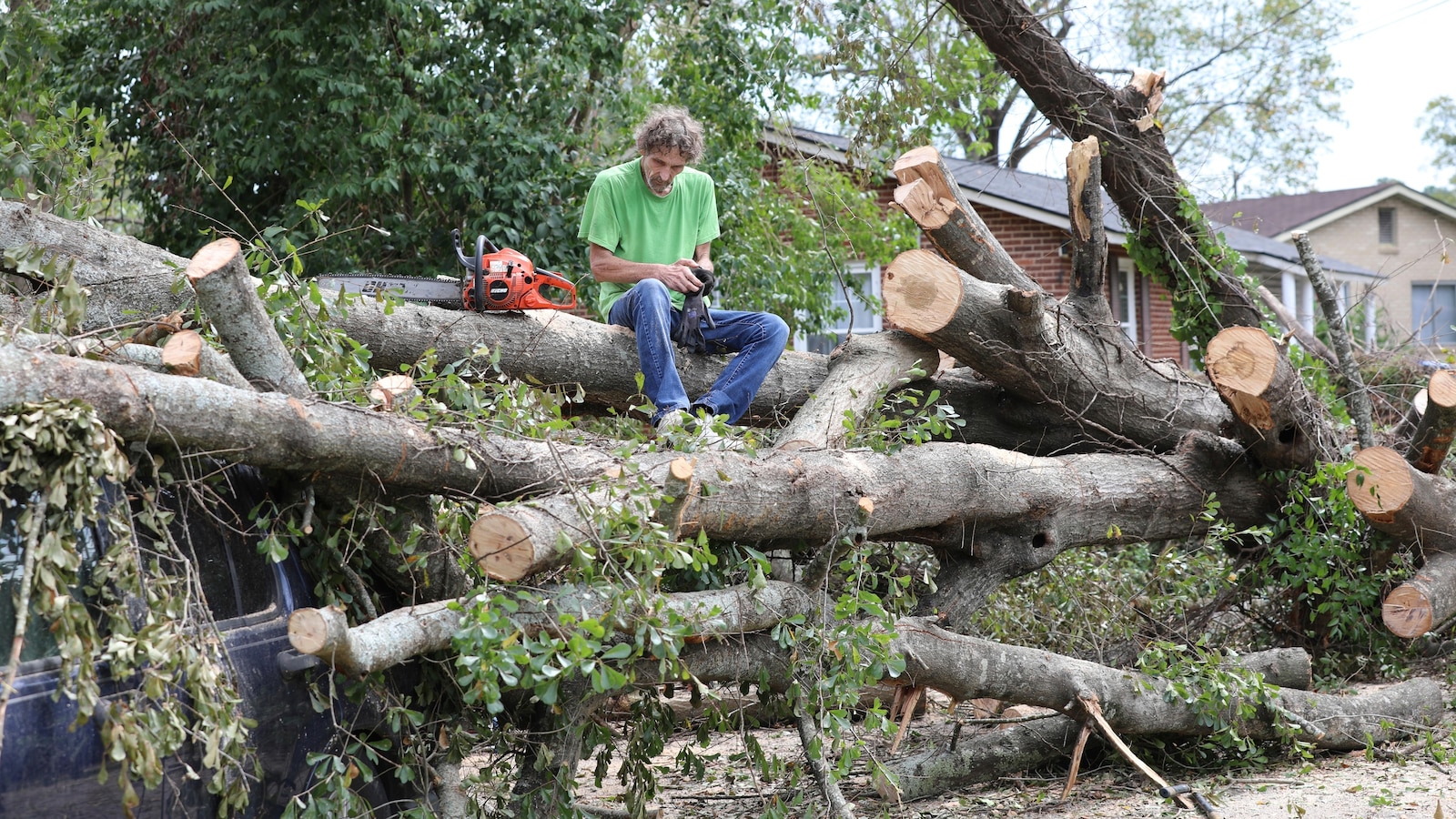As former President Donald Trump and Vice President Kamala Harris spend the run up to the last stretch of the 2024 election barnstorming through battleground states, a contrast has emerged: Trump has single-handedly outpaced both Harris and her running mate, Minnesota Gov. Tim Walz, in campaign events for the month of September as he shows no signs of slowing down — a strategy his campaign is employing to focus on counties vulnerable to flipping.
In September, Trump held 21 public campaign events including remarks, rallies, press conferences and town halls. That’s compared to Harris’ 13 campaign events; Walz had seven campaign events, according to campaign schedules ABC News has reviewed. On top of Trump’s jam-packed campaign schedule, his running mate, Sen. JD Vance, alone held 14 events in the month of September.
These tallies do not include brief campaign retail stops and appearances without remarks.
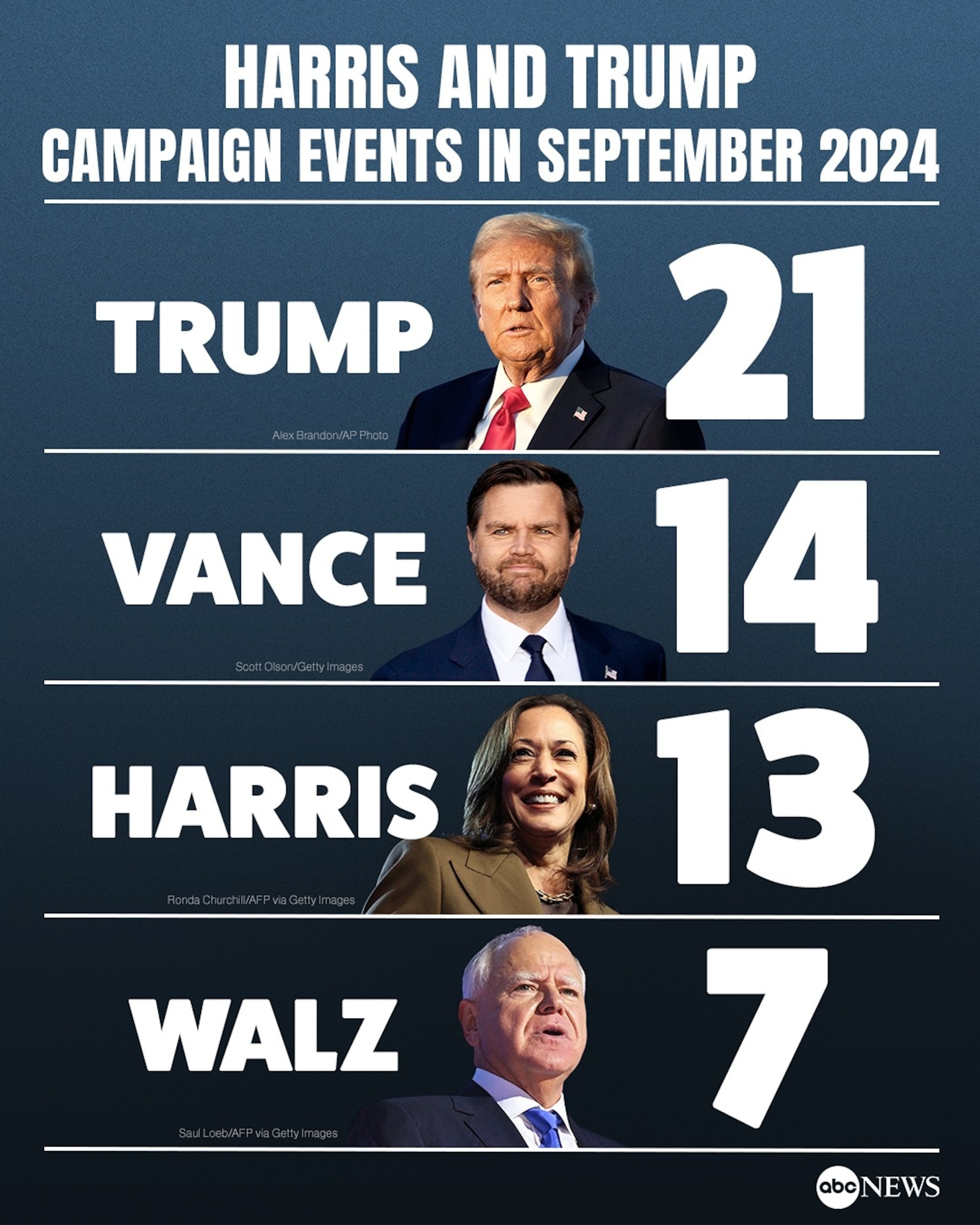
Harris and Trump campaign events in September 2024
ABC News Photo Illustration, AFP via Getty Images, AP Photo, Getty Images
The intensity in Trump’s campaign schedule has continued into the first week of October. From Oct. 1 through Oct. 6, Trump has already held eight campaign events compared to Harris, who has held two, according to an ABC News review of their schedules.
Recently Harris has spent her days focused on her official duties as vice president receiving Federal Emergency Management Agency briefings and surveying Hurricane Helene’s damage in Georgia and North Carolina. Trump similarly visited Georgia to survey the storm damage and received his own briefings from local officials.
Harris campaign advisers have dismissed arguments that Harris isn’t campaigning hard enough, pointing to the eight events she had done throughout the month in her official capacity as vice president including a trip down to the southern border along with dealing with the devastation from Hurricane Helene.
Harris campaign spokesperson Sarafina Chitika said in a statement that Trump is “cocooned in a conservative media bubble” and “limiting his time in battleground states,” while Harris and Walz are “taking tough questions and meeting voters where they are.”
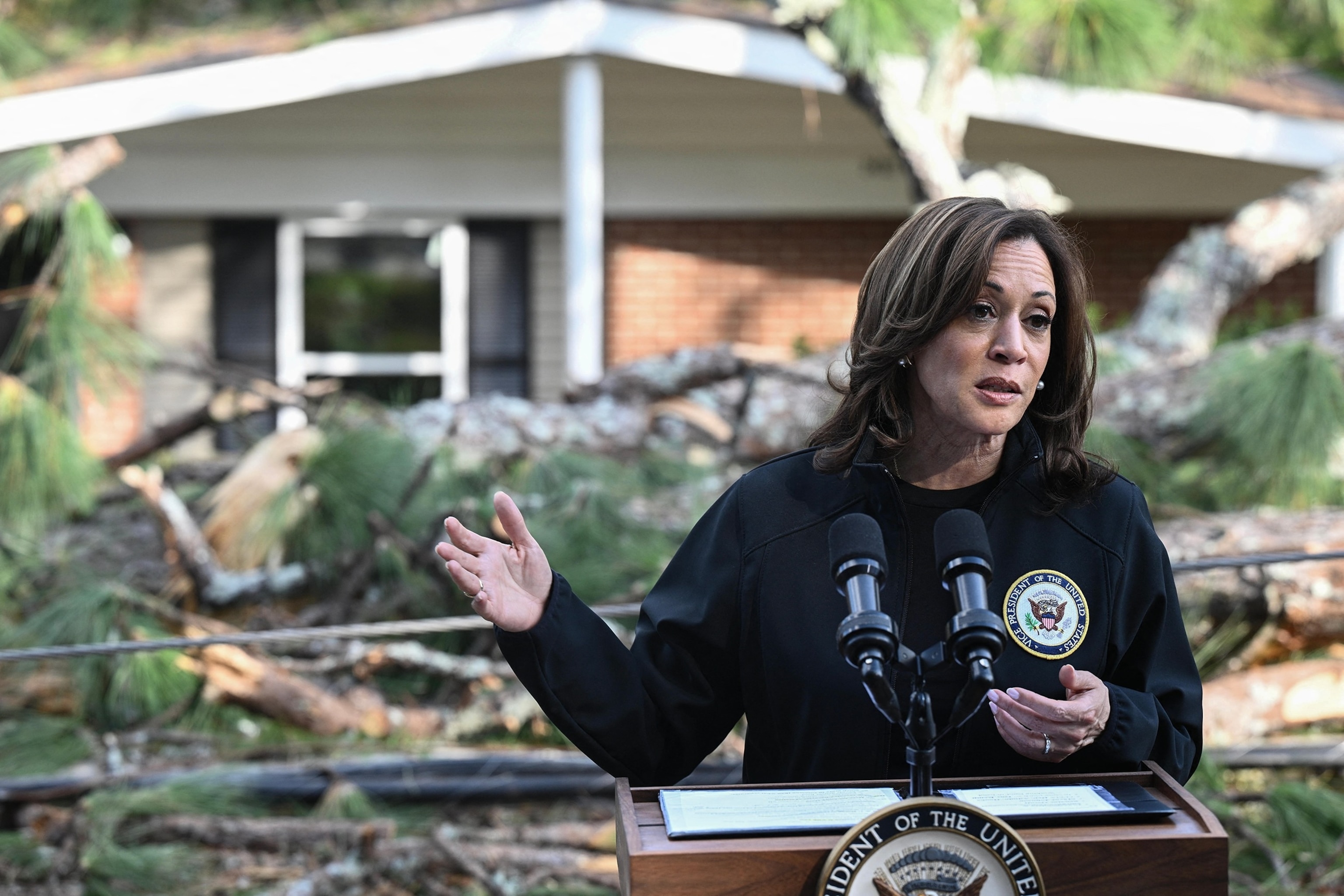
Vice President Kamala Harris speaks after she surveyed the damage from Hurricane Helene, in the Meadowbrook neighborhood of Augusta, Ga., Oct. 2, 2024.
Brendan Smialowski/AFP via Getty Images
“In the home stretch, Donald Trump is campaigning in California, Chicago, and New York City, after camping out at Mar-A-Lago avoiding voters,” Chitika wrote in the statement.
However, in recent weeks, Trump has been campaigning across multiple battleground states, which have included multiple appearances in Wisconsin, Pennsylvania, Michigan and North Carolina, as he enters a crucial phase of his campaign and vies to make a final pitch to voters ahead of Election Day.
“I go to a lot of places, we’re definitely outworking the opposition. She’ll go to one place in three days. I say, ‘Why can’t I do that?'” Trump quipped at a campaign stop in Savannah, Georgia, late last month.
Earlier this election cycle, Trump was falling behind in the number of campaign events compared to his nonstop rallying during the 2016 election. Trump, who had early victories in primary races, had fewer events amid his legal battles, which kept him confined in a courtroom most days of the week.
But he has picked up the pace in the final months ahead of the election.
The former president has spent most of his time in the past month in the commonwealth of Pennsylvania, holding four events in September there as polling shows it’s the closest state on the map between the two candidates. Harris only has a 0.4% lead over Trump in Pennsylvania, according to 538’s polling average.
Trump’s events have been concentrated in urban-suburban areas in battleground states that flipped between his two presidential runs as his campaign hopes to eat away at Democratic margins.
For example, last month, Trump gave remarks at a manufacturing plant in Walker, Michigan, in Kent County — a county that President Joe Biden flipped from Trump in 2020. Later in the day, Trump hosted a town hall in Warren, Michigan, which sits just outside of Detroit and was the only county in 2020 in the tri-county region that flipped to Trump in the past two cycles after former President Barack Obama won the county in 2008 and 2012.
Two weeks ago, Trump visited Prairie Du Chien in Crawford County, Wisconsin — a southwest county in the state that is among several in the region that flipped from Obama to Trump. Now, Trump is trying to win back voters in these pivotal counties after he narrowly lost the state to Biden by 21,000 votes in 2020.
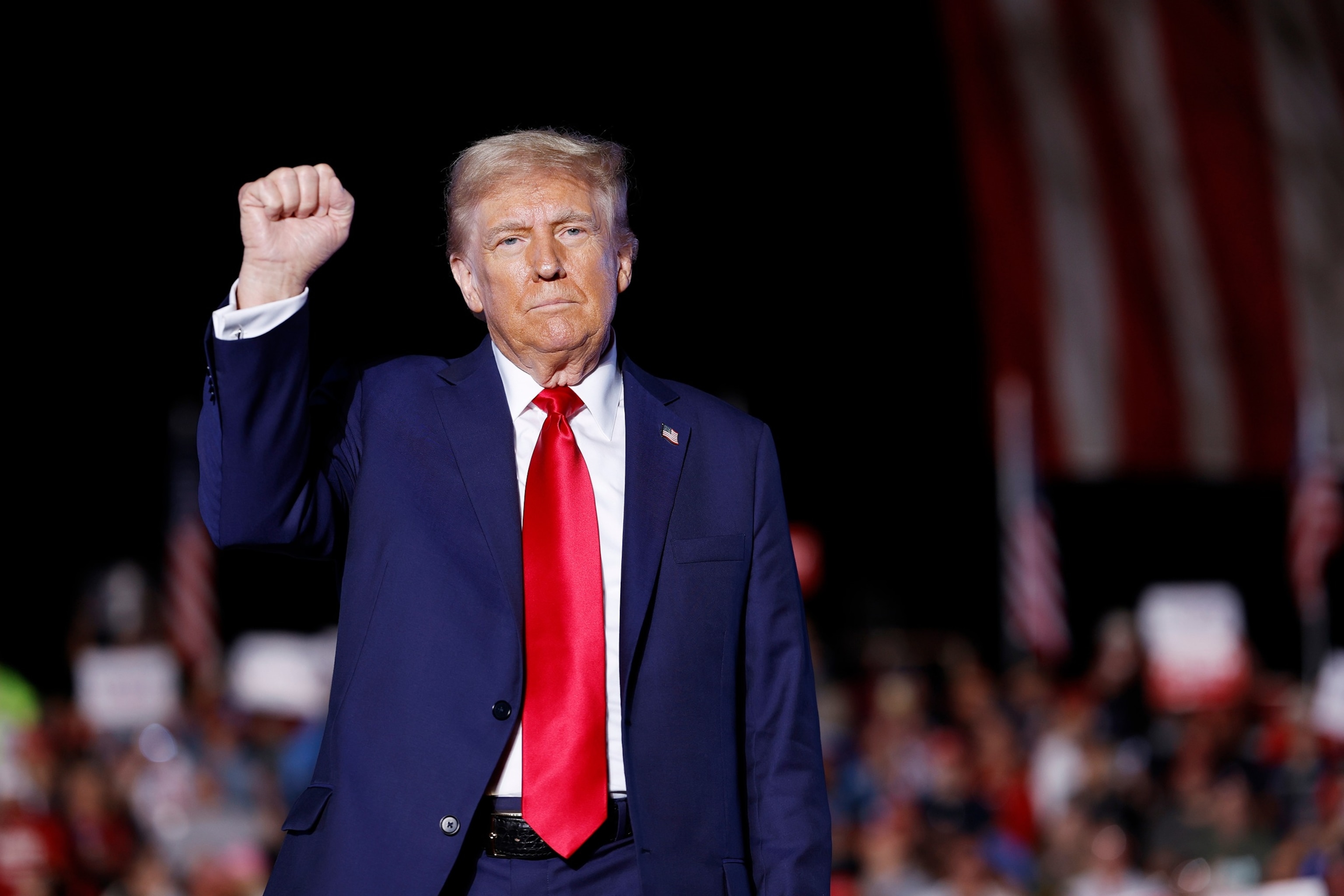
Former President Donald Trump holds up his fist as he walks offstage at the end of a campaign rally at the Butler Farm Show fairgrounds in Butler, Pa., Oct. 05, 2024.
Anna Moneymaker/Getty Images
Last week, Trump marked his fourth visit to Wisconsin in eight days with events in Milwaukee and Dane counties — two Democratic strongholds. He went on to campaign on Sunday in Juneau, Wisconsin, in Dodge County — a county that has increasingly been turning into a Republican stronghold over the last few presidential elections.
Harris has similarly focused on Pennsylvania, holding five events in the commonwealth. She has spent much of her time in Western and central Pennsylvania, drawing crowds from both the Democratic-leaning Pittsburgh area as well as rural counties that have been wavering between strong and slight Republican leanings.
The schedule contrast comes as the Harris campaign, and previously Biden’s, have been critical of Trump’s slow pace on the road earlier in the cycle, arguing he was campaigning from “his country club basement.”
In the early weeks of August, on the heels of Biden’s withdrawal from the 2024 election, Trump only had a smattering of events in Republican-safe states, spending most of his time at private fundraisers and participating in online interviews including with tech entrepreneur Elon Musk and streamer Adin Ross.
Harris began introducing herself to the nation by holding multiple events in the beginning weeks of her campaign and drawing big crowds from that momentum — especially in the second week of August when the Harris-Walz ticket held five joint rallies across the country — but has since failed to keep up with that pace. At times, Harris has focused on her official duties as vice president instead or simply had no public campaign or vice presidential schedules announced.
Additionally, Harris and Walz have both received public scrutiny for their careful campaigning methods, both largely avoiding media availability on the road and sit-down interviews, something the Trump and his running mate, Sen. JD Vance both routinely do.
Recently, however, the Harris-Walz campaign has announced a series of media interviews including appearances on the “Call Her Daddy” podcast, ABC’s “The View,” CBS News’ “60 Minutes,” and the “Howard Stern Show” for Harris. Walz is set to do interviews on the “Smartless” podcast and “Jimmy Kimmel Live” this week.
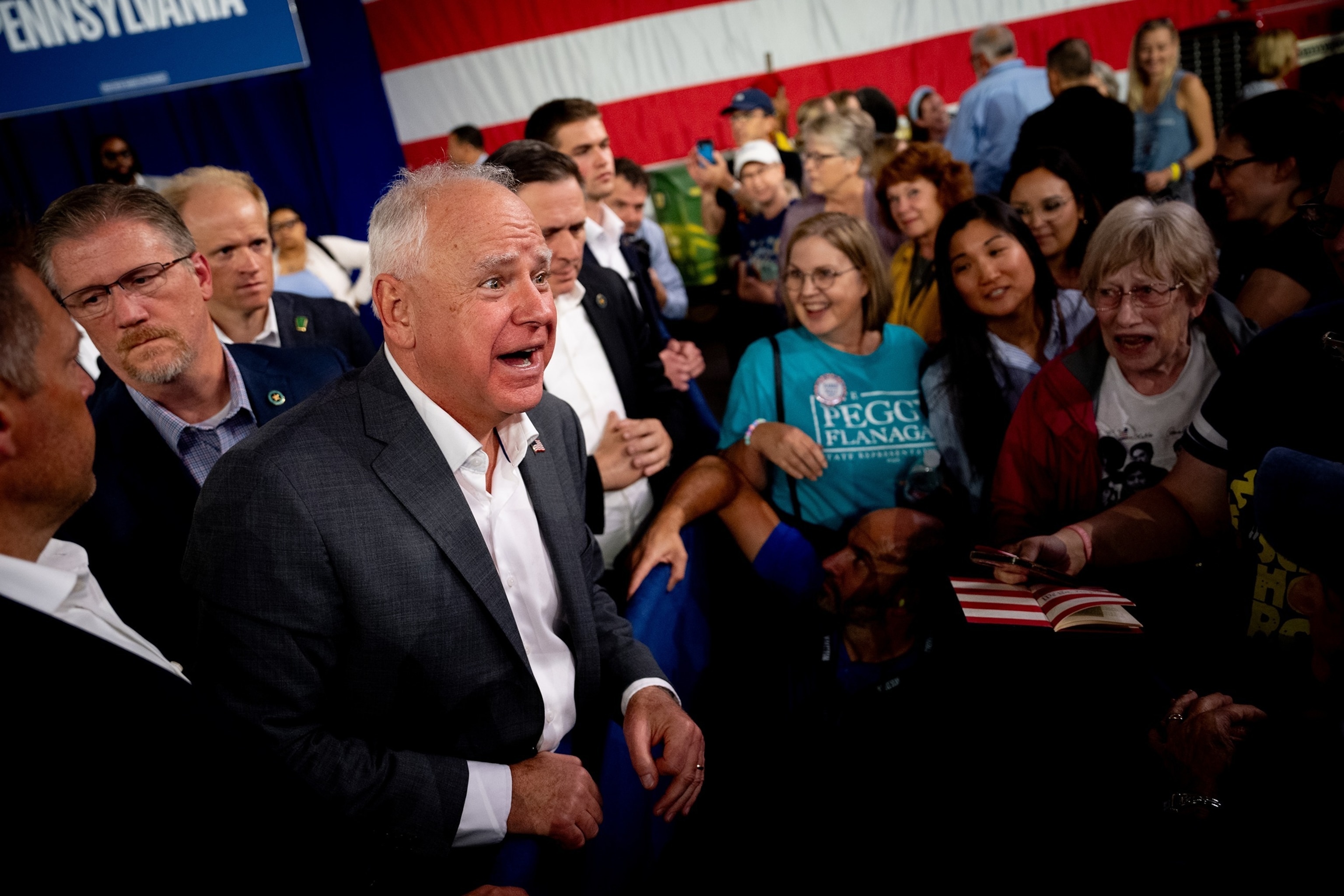
Democratic vice presidential candidate Minnesota Gov. Tim Walz greets supporters after speaking at a rally at York Exposition Center UPMC Arena in York, Pa., Oct. 2, 2024.
Andrew Harnik/Getty Images
The latest polling average from 538 shows Harris is gaining momentum nationally, leading Trump by 2.6%, but a recent New York Times/Siena College poll shows a tighter race with the two candidates neck-and-neck among registered voters in Michigan and Wisconsin. Another New York Times/Siena College poll a week prior showed Trump leading in the battleground states of Arizona and North Carolina.
As he enters the final stages of the campaign, Trump has publicly acknowledged the importance of the last weeks of his campaign, often telling his supporters that he isn’t taking anything for granted. Trump’s campaign has said the former president is aware of the stakes of the election as he enters the final stages and hopes his message on immigration and economy — two key issues for voters this election — resonate.
Trump has said he plans to leave everything on the field as Election Day draws near.
“We’re going to leave nothing to chance and everything on the field … and we’re going to defeat Kamala Harris, and we’re going to make America great again,” Trump said at a campaign stop in Waunakee, Wisconsin, last week.
Harris, going into the final stretch of the election, has stressed that she’s running as an “underdog” in what’s shaping up to be a close race.
“This is a margin-of-error race. We are the underdog. And I am running like the underdog because I am the underdog in this race. The baton is now in our hands,” Harris said at a fundraiser in San Francisco in late September.
While falling behind Trump in formal campaign remarks, the Harris campaign has filled their schedule for both candidates with retail campaign stops, seeing value in fostering environments where their candidates can have more face time with voters, as well as fundraisers that has allowed them to wipe out Trump’s campaign money edge from earlier this year.
As the 2024 presidential election cycle begins to ramp up, campaign events are becoming more frequent and competitive among potential candidates. Among those who have already thrown their hats into the ring are former President Donald Trump, Vice President Kamala Harris, and Minnesota Governor Tim Walz. As they hit the campaign trail, it is becoming clear that Trump is leading the pack in terms of drawing crowds and generating excitement.
Trump, who has remained a prominent figure in the Republican Party since leaving office, has been holding large rallies across the country, drawing thousands of supporters eager to hear him speak. His events have been marked by his trademark fiery rhetoric and attacks on the Biden administration, which have resonated with his base. Despite facing criticism from some within his own party for his handling of the 2020 election and the Capitol riot, Trump’s popularity among Republican voters remains strong.
In contrast, Vice President Kamala Harris has struggled to generate the same level of enthusiasm at her campaign events. While she has been making appearances at fundraisers and town halls, her events have not drawn the same size crowds as Trump’s rallies. Harris, who is seen as a frontrunner for the Democratic nomination, has faced criticism for her handling of the border crisis and other issues, which has dampened some of the excitement surrounding her candidacy.
Meanwhile, Governor Tim Walz has been making a strong showing in early campaign events, particularly in key battleground states like Minnesota. Walz, who has been praised for his handling of the COVID-19 pandemic in his state, has been drawing large crowds at his events and generating positive media coverage. While he may not have the name recognition of Trump or Harris, Walz’s message of unity and progressivism has resonated with voters looking for a fresh face in politics.
Overall, the comparison of campaign events among Trump, Harris, and Walz in the 2024 election cycle run-up shows that Trump is currently leading the pack in terms of drawing crowds and generating excitement. However, it is still early in the campaign season, and much can change in the coming months as candidates continue to make their case to voters. It will be interesting to see how these dynamics evolve as the race heats up and more candidates enter the fray.
